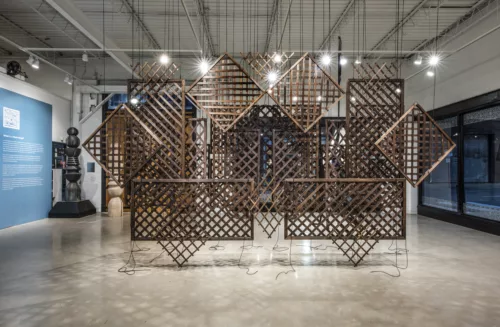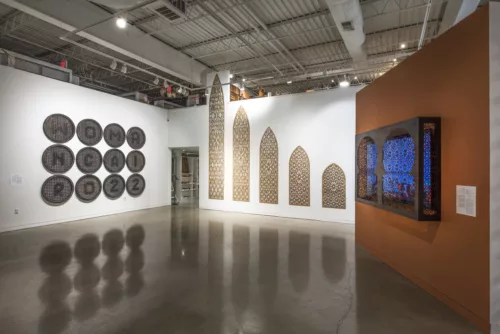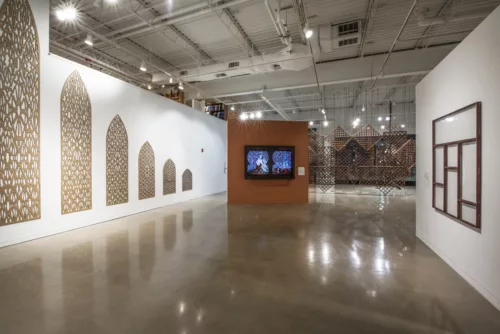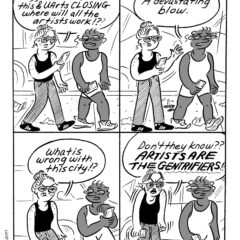The Mashrabiya Project: Seeing Through Space at the Museum for Art in Wood is a community-focused exploration of the mashrabiya, an ancient and traditional Islamic architectural lattice treatment made of wooden or stone that is carved by hand, or turned on a lathe, and usually placed on the upper levels of a building. In traditional contexts, such structures would offer control over visibility, temperature, and exposure. The exhibition includes the work of six artists from across the Islamic world, each exploring space and sight, as well as visibility, Orientalism, feminism, and constructions of national and personal identity in relation to the mashrabiya.

Mashrabiya are a passive form of air conditioning, cooling air that passes through the lattice spaces into the houses of North Africa, West Asia, and South Asia. However, these decorative window treatments were created to be gender boundaries inside interior spaces while also providing shade. The mashrabiya became a framework for artisanal and decorative skills within the limits of representational imagery allowed by the tenets of Islam. Such elaborate designs and geometric patterning are a defining feature of Islamic visual culture, ornament and architecture.
An example of these intricacies can be seen in Susan Hefuna’s Woman Cairo 2022. Hefuna, born in Berlin, Germany and raised in Egypt, often uses mashrabiya to investigate cultural boundaries, the invasiveness of the male gaze, and the limits placed on women living in religious cultures. Woman Cairo 2022, made of twelve black roundels in four horizontal columns and three vertical, forms a subtle yet apparent letter, ultimately spelling out Woman Cairo 2022. In this work, Hefuna combines the geometric intricacies of Islamic architecture with the oculus and rose window traditions of the Catholic Church. The invisible actors of Islamic society are visible in the roundels, in the writing of the women’s places and the associated dates.

Tunisian born artist Nadia Kaabi-Linke’s work Amina’s Tears, a series of seven rectilinear frames, each holding a manipulated acrylic window pane, makes up a large wooden window casing. The title of Kaabi-Linke’s work is taken from Naguid Mahfouz’s Cairo Trilogy (1956-57). In the twenty years following World War II, Amina, the matriarch of the al-Jawad family, is concealed in her home away from public spaces, experiencing life, joy, and sorrow, from behind a mashrabiya. From the right corner, a subtle shadow is cast in a mashrabiya pattern signaling the complexity of women’s lives. The distinct pattern draws your eye toward the left where the shadows take on a watery effect, akin to the effects of a mashrabiya as a window/barrier.
Majida Khattari, a Moroccan-born Parisian-based interdisciplinary artist, tells the stories of women’s experiences in Arab society in a series of portraits of Philadelphians, who avoid easy classification. Dressed in garments that recall so-called Orientalist dress, in environments of opulent textures and colors; despite the traditional setting, their direct eye contact and non-classifiable identities challenge the standards that Orientalist art purports to represent. Orientalism, an academic discipline and subject of art making in the 19th century, depicted a romanticized and fetishized view of the Middle East and Asia. The viewer can only see these portraits through a mashrabiya, thus the power of the gaze is returned to the sitters.

Nidaa Badwan, a multidisciplinary artist born in Abu Dhabi, UAE and raised in Gaza, displays photographs titled Love behind the Mashrabiya 1 and 2. These theatrical images depict the joy and beauty experienced behind the mashrabiya. The photos draw on the freeing power of the mashrabiya, which conceals and allows for unrestrained expression. Badwan says of her work, “Behind the mashrabiya, they are all the same, they sing, dance, have fun. Only back there.” Badwan’s portraits of joy and harmony show the boundary-making mashrabiya as a liberating element in the domestic space.
The works of The Mashrabiya Project collectively refer to the experience of women in Arab society as well as global issues that pressure the regions, the experiences of civil war, western demonization, and colonial struggle. Exquisite geometric designs remind the viewer of the contributions of Islamic societies that have been demonized by the western world. Each of the six artists repurposes the traditions of the mashrabiya to push forward and honor the tradition. The artists are all female presenting, and the work shown reflects the invisibility women face within Islamic culture and society. Having grown up in a Pakistani family, I have seen firsthand the demeaning experience that women and LGBTQ+ people experience from men in these families and their society. These works confront this restrictive gender conformity, queer identities in a religious society, and the limited place of women in Islamic society, as well as challenging Orientalist attitudes.
The Mashrabiya Project featuring works by (L to R) Susan Hefuna, Nadia Kaabi-Linke, and Majida Khattari. Image courtesy of The Museum for Art in Wood.
The Mashrabiya Project featuring works by (L to R) Nadia Kaabi-Linke, Majida Khattari, and Nadia Kaabi-Linke. Image courtesy of The Museum for Art in Wood.
Mashrabiya #9 by Hoda Tawakol. Image courtesy of The Museum for Art in Wood.








